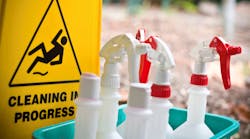When used properly, both conventional and green cleaning chemicals are relatively safe. However, accidents do happen and there are precautions that should be taken for the proper handling of cleaning solutions.
This is one reason why the U.S. Department of Labor continues to list cleaning and custodial work as one of the most dangerous jobs in the country, mainly because of the many accidents involving chemicals that occur each year.
Here are the key components of a cleaning chemical safety program:
- A complete list of all cleaning chemicals used in the facility; this documentation should include details such as how many gallons (and multiple-gallon containers) are stored, where they are stored and the potential hazards of and necessary precautions for each specific chemical (for instance, whether or not a chemical needs to be kept away from direct sunlight).
- Safety data sheets (SDS) for each chemical used or stored.
- Keeping all cleaning chemicals in their original containers and never mixing chemicals, even if they are the same “type” of chemical.
- Storing chemicals in well-ventilated areas away from HVAC intake vents. This helps prevent any fumes from spreading to other areas of the facility.
- Installing safety signage in multiple languages (or, even better, using images and no words) that quickly conveys possible dangers and precautions related to the chemicals.
- Making sure all cleaning workers know exactly what the following “signal words” mean:
- Caution - the product should be used carefully but is relatively safe;
- Warning - the product is moderately toxic;
- Danger - the product is highly toxic and may cause permanent damage to skin and eyes.
“Cleaning chemical safety programs should also include getting rid of chemicals that have not been used for a prolonged period of time,” says Jennifer Meek, director of marketing and customer relations for Enviro-Solutions. “A good rule of thumb is to consider disposing of any chemical product that has not been used for 6 months, and disposing of any product that has not been used for a year.”

